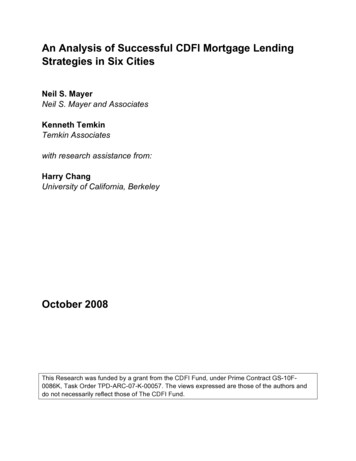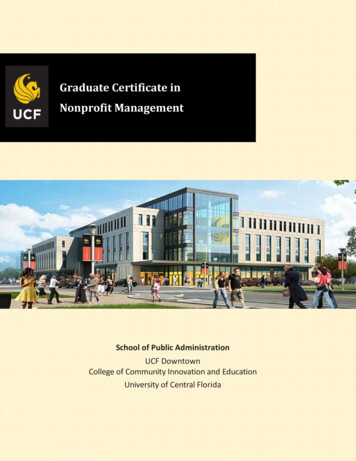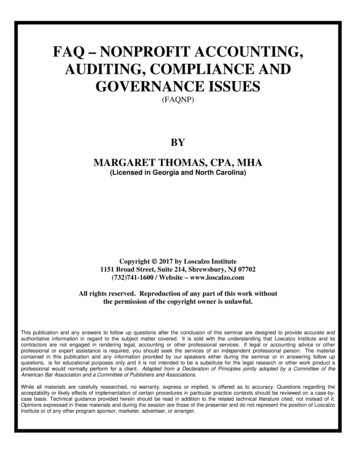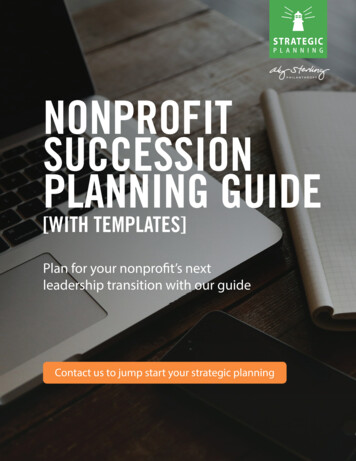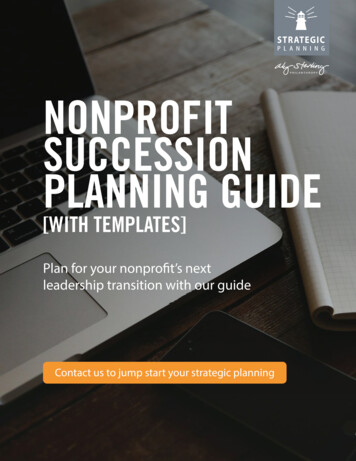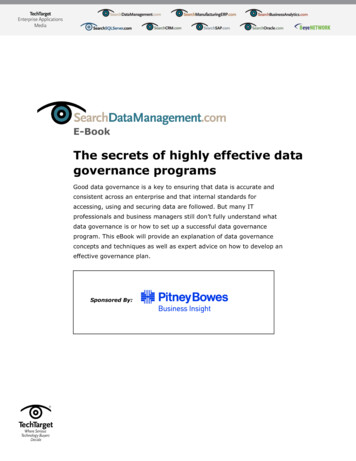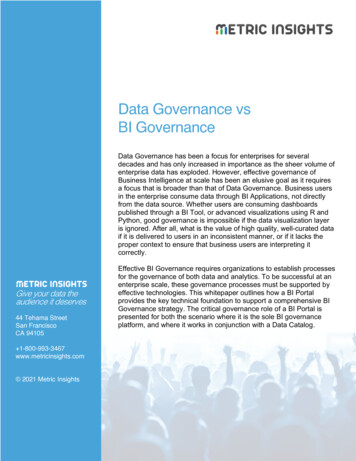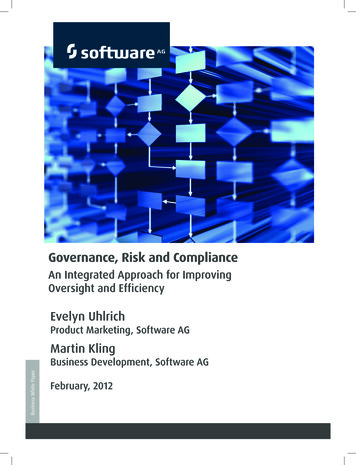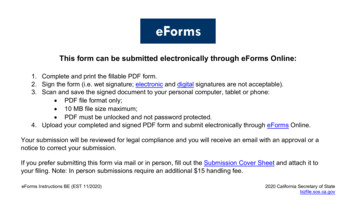
Transcription
“. an exceptional resource for nonprofit boards and leaders.”—David O. Renz, Beth K. Smith/Missouri Chair in Nonprofit Leadership,Midwest Center for Nonprofit Leadership, University of Missouri, Kansas CityThe Handbook ofNonprofitGover nance
THE HANDBOOK OF NONPROFITGOVERNANCE
Essential Texts for Nonprofit and Public Leadershipand ManagementThe Handbook of Nonprofit Governance, by BoardSourceStrategic Planning for Public and Nonprofit Organizations, third edition, by John M. BrysonThe Effective Public Manager, fourth edition, by Steven Cohen et al.Handbook of Human Resources Management in Government, third edition, by Stephen E. CondreyThe Responsible Administrator, fifth edition, by Terry L. CooperConducting a Successful Capital Campaign, revised and expanded edition, by Kent E. DoveThe Public Relations Handbook for Nonprofits, by Arthur FeinglassThe Jossey-Bass Handbook of Nonprofit Leadership and Management, second edition,by Robert D. HermanBenchmarking in the Public and Nonprofit Sectors, second edition, by Patricia Keehley et al.Museum Marketing and Strategy, second edition, by Neil Kotler et al.The Ethics Challenge in Public Service, second edition, by Carol W. Lewis et al.Working Across Boundaries, by Russell M. LindenDesigning and Planning Programs for Nonprofit and Government Organizations, by Edward J. PawlakMeasuring Performance in Public and Nonprofit Organizations, by Theodore H. PoisterHuman Resources Management for Public and Nonprofit Organizations: A Strategic Approach, thirdedition, by Joan E. PynesUnderstanding and Managing Public Organizations, fourth edition, by Hal G. RaineyDesigning and Conducting Survey Research, third edition, by Louis M. Rea et al.Fundraising Principles and Practice, by Adrian Sargeant et al.Making Critical Decisions, by Roberta M. Snow et al.Hank Rosso’s Achieving Excellence in Fundraising, second edition, Eugene R. TempelHandbook of Practical Program Evaluation, second edition, by Joseph S. Wholey et al.
%THE HANDBOOKOF NONPROFITGOVERNANCE
Copyright 2010 by BoardSource. All rights reserved.Published by Jossey-BassA Wiley Imprint989 Market Street, San Francisco, CA 94103-1741—www.josseybass.comNo part of this publication may be reproduced, stored in a retrieval system, or transmitted in any formor by any means, electronic, mechanical, photocopying, recording, scanning, or otherwise, except aspermitted under Section 107 or 108 of the 1976 United States Copyright Act, without either the priorwritten permission of the publisher, or authorization through payment of the appropriate per-copy feeto the Copyright Clearance Center, Inc., 222 Rosewood Drive, Danvers, MA 01923, 978-750-8400, fax978-646-8600, or on the Web at www.copyright.com. Requests to the publisher for permission shouldbe addressed to the Permissions Department, John Wiley & Sons, Inc., 111 River Street, Hoboken, NJ07030, 201-748-6011, fax 201-748-6008, or online at www.wiley.com/go/permissions.Readers should be aware that Internet Web sites offered as citations and/or sources for furtherinformation may have changed or disappeared between the time this was written and when it is read.Limit of Liability/Disclaimer of Warranty: While the publisher and author have used their bestefforts in preparing this book, they make no representations or warranties with respect to the accuracyor completeness of the contents of this book and specifically disclaim any implied warranties ofmerchantability or fitness for a particular purpose. No warranty may be created or extended by salesrepresentatives or written sales materials. The advice and strategies contained herein may not be suitablefor your situation. You should consult with a professional where appropriate. Neither the publisher norauthor shall be liable for any loss of profit or any other commercial damages, including but not limited tospecial, incidental, consequential, or other damages.Jossey-Bass books and products are available through most bookstores. To contact Jossey-Bass directlycall our Customer Care Department within the U.S. at 800-956-7739, outside the U.S. at 317-572-3986,or fax 317-572-4002.Jossey-Bass also publishes its books in a variety of electronic formats. Some content that appears in printmay not be available in electronic books.Library of Congress Cataloging-in-Publication DataThe handbook of nonprofit governance / Boardsource.p. cm.—(Nonprofit and public leadership and management)Includes bibliographical references and index.ISBN 978-0-470-45763-4 (cloth)1. Nonprofit organizations—Management. 2. Corporate governance. 3. Boards ofdirectors. 4. Nonprofit organizations—Management—Case studies. 5. Corporategovernance—Case studies. 6. Boards of directors—Case studies. 7. BoardSource (Organization)I. BoardSource (Organization)HD62.6.H345 2010658.4'22—dc222010004073Printed in the United States of AmericaFIRST EDITIONHB Printing10 9 8 7 6 5 4 3 2 1
BoardSource is dedicated to advancing the public good by building exceptionalnonprofit boards and inspiring board service.BoardSource was established in 1988 by the Association of Governing Boardsof Universities and Colleges (AGB) and Independent Sector (IS). In the early1980s, the two organizations had conducted a survey and found that although30 percent of respondents believed they were doing a good job of board education and training, the rest of the respondents reported little, if any, activity instrengthening governance. As a result, AGB and IS proposed the creation of anew organization whose mission would be to increase the effectiveness of nonprofit boards.With a lead grant from the Kellogg Foundation and funding from five otherdonors, BoardSource opened its doors in 1988 as the National Center forNonprofit Boards. It had a staff of three and an operating budget of 385,000.On January 1, 2002, BoardSource took on its new name and identity. Thesechanges were the culmination of an extensive process of understanding howwe were perceived, what our audiences wanted, and how we could best meet theneeds of nonprofit organizations.Today BoardSource is the premier voice of nonprofit governance. Its highlyacclaimed products, programs, and services mobilize boards so that organizationsfulfill their missions, achieve their goals, increase their impact, and extend theirinfluence. BoardSource is a 501(c)(3) organization.BoardSource provides Resources to nonprofit leaders through workshops, training, and an extensiveWeb site (www.boardsource.org) Governance consultants who work directly with nonprofit leaders to designspecialized solutions to meet an organization’s needs The world’s largest, most comprehensive selection of material on nonprofitgovernance, including a large selection of books and CD-ROMs An annual conference that brings together approximately nine hundred governance experts, board members, and chief executives and senior staff fromaround the worldFor more information, please visit our Web site at www.boardsource.org, e-mailus at mail@boardsource.org, or call us at 800-883-6262.
Have You Used These BoardSource Resources?The Governance SeriesTen Basic Responsibilities of Nonprofit Boards, second editionFinancial Responsibilities of Nonprofit Boards, second editionStructures and Practices of Nonprofit Boards, second editionFundraising Responsibilities of Nonprofit Boards, second editionLegal Responsibilities of Nonprofit Boards, second editionThe Nonprofit Board’s Role in Mission, Planning, and Evaluation, second editionThe Committee SeriesTransforming Board Structure: Strategies for Committees and Task ForcesGovernance CommitteeExecutive CommitteeFinancial CommitteesDevelopment CommitteeAdvisory CouncilsOther BooksThe Board Building Cycle: Nine Steps to Finding, Recruiting, and Engaging NonprofitBoard Members, second editionThe Board Chair Handbook, second editionThe Business Professional’s Guide to Nonprofit Board ServiceChief Executive Succession Planning: Essential Guidance for Boards and CEOs,second editionChief Executive Transitions: How to Hire and Support a Nonprofit CEOCulture of Inquiry: Healthy Debate in the BoardroomDriving Strategic Planning: A Nonprofit Executive’s Guide, second editionExceptional Board Practices: The Source in ActionFearless Fundraising for Nonprofit Boards, second editionGenerating Buzz: Strategic Communications for Nonprofit BoardsGetting the Best from Your Board: An Executive’s Guide to a Successful PartnershipGovernance as Leadership: Reframing the Work of Nonprofit BoardsManaging Conflicts of Interest: A Primer for Nonprofit Boards, second editionMeeting, and Exceeding Expectations: A Guide to Successful Nonprofit Board Meetings,second editionMoving Beyond Founder’s Syndrome to Nonprofit Success
Navigating the Organizational Lifecycle: A Capacity-Building Guide for Nonprofit LeadersThe Nonprofit Board Answer Book: A Practical Guide for Board Members and Chief Executives,second editionThe Nonprofit Board’s Guide to Bylaws: Creating a Framework for Effective GovernanceThe Nonprofit Chief Executive’s Ten Basic ResponsibilitiesNonprofit Executive Compensation: Planning, Performance, and Pay, second editionThe Nonprofit Dashboard: A Tool for Tracking ProgressNonprofit Governance: Steering Your Organization with Authority and AccountabilityThe Nonprofit Legal LandscapeThe Nonprofit Policy Sampler, second editionThe Source: Twelve Principles of Governance That Power Exceptional BoardsTaming the Troublesome Board MemberTrouble at the Top: The Nonprofit Board’s Guide to Managing an Imperfect Chief ExecutiveUnderstanding Nonprofit Financial Statements, third editionWho’s Minding the Money? An Investment Guide for Nonprofit Board Members,second editionOnline AssessmentsAssessment of the Chief ExecutiveBoard Self-Assessment
Join Us atJosseybass.comJoRegister at www.josseybass.com/emailfor more information on our publications,authors, and to receive special offers.
CONTENTSAbout BoardSourcevAcknowledgmentsxiIntroductionxvPART ONE: GOVERNANCE PRINCIPLES, ROLES, AND STRUCTURE11 In the Spirit of Service: Introduction to the Nonprofit World 32 What Is Governance? 153 Governance Roles 314 Governance Structure 555 The Board–Chief Executive Relationship 81PART TWO: GOVERNANCE PRACTICES 976 Building a Board997 Legal and Ethical Responsibilities 127ix
xContents8 Financial Oversight 1459 Fundraising 16710 Strategic Thinking and Strategic Planning 18911 Communications and Outreach 21112 Succession Planning and Chief Executive Transition 23313 Evaluation25514 Bylaws and Policies27515 Board Meetings 29516 Board Dynamics 317Appendix: Sample Policies for Nonprofit BoardsBoard Member Fundraising 332Human ResourcesCode of Ethics333335Conflict of InterestConfidentiality337341Whistle-Blower Protection342Record Retention and Document DestructionExecutive CompensationInvestments350Financial Audits356Risk ManagementMedia RelationsGlossary 359Resources 367Index375357358348344331
ACKNOWLEDGMENTSBoardSource wishes to acknowledge the authors of the material used inproducing this handbook:Nancy R. Axelrod, Advisory Councils (BoardSource Committee Series); ChiefExecutive Succession Planning: Essential Guidance for Boards and CEOs (second edition);Culture of Inquiry: Healthy Debate in the Boardroom; “Curious Boards,” Board Member15, no. 3 (May/June 2006).Steven Berger, Understanding Nonprofit Financial Statements (third edition).BoardSource, The Nonprofit Board Answer Book: A Practical Guide for Board Members andChief Executives (second edition).BoardSource, The Source: Twelve Principles of Governance That Power ExceptionalBoards.Marla J. Bobowick, Sandra R. Hughes, and Berit M. Lakey, Transforming BoardStructure: Strategies for Committees and Task Forces (BoardSource Committee Series).Janet Boguch, “Enforcing Give, Get, or Get Off,” Board Member 17, no. 1 (January/February 2008).Lawrence M. Butler, The Nonprofit Dashboard: A Tool for Tracking Progress.Richard P. Chait, William P. Ryan, and Barbara E. Taylor, Governance as Leadership:Reframing the Work of Nonprofit Boards.xi
xiiAcknowledgmentsPaul M. Connolly, Navigating the Organizational Lifecycle: A Capacity-Building Guide forNonprofit Leaders.Charles F. Dambach, MBA, Melissa Davis, and Robert L. Gale, Structures andPractices of Nonprofit Boards (second edition) (BoardSource Governance Series).Charles F. Dambach, MBA, Oliver Tessier, and Carol E. Weisman, The BusinessProfessional’s Guide to Nonprofit Board Service.M. Christine DeVita, “Constructing a Partnership,” Board Member 15, no. 5(September/October 2006).Outi Flynn, Meeting, and Exceeding Expectations: A Guide to Successful Nonprofit BoardMeetings (second edition).Robert P. Fry Jr., Who’s Minding the Money? An Investment Guide for Nonprofit BoardMembers (second edition).Kay Sprinkel Grace, MA, “Fundraising in the 21st Century,” Board Member 17,no. 3 (May/June 2008).Kay Sprinkel Grace, MA, Amy McClellan, MNO, and John A. Yankey, PhD,The Nonprofit Board ’s Role in Mission, Planning, and Evaluation (second edition)(BoardSource Governance Series).James M. Greenfield, Fundraising Responsibilities of Nonprofit Boards (second edition),ACFRE, FAHP (BoardSource Governance Series).Peter Dobkin Hall, “A History of Nonprofit Boards in the United States.”Deborah S. Hechinger and Marla J. Bobowick, “Governance Matters,” BoardMember 14, no. 3 (June/July 2005).Bruce R. Hopkins, JD, LLM, Legal Responsibilities of Nonprofit Boards (second edition)(BoardSource Governance Series).Richard T. Ingram, Ten Basic Responsibilities of Nonprofit Boards (second edition)(BoardSource Governance Series).Katha Kissman, Taming the Troublesome Board Member.Katha Kissman, Trouble at the Top: The Nonprofit Board’s Guide to Managing an ImperfectChief Executive.Daniel L. Kurtz and Sarah E. Paul, Managing Conflicts of Interest: A Primer for NonprofitBoards (second edition).Berit M. Lakey, The Board-Building Cycle: Nine Steps to Finding, Recruiting, and EngagingNonprofit Board Members (second edition); Nonprofit Governance: Steering Your Organizationwith Authority and Accountability.Berit M. Lakey, Sandra Hughes, and Outi Flynn, Governance Committee (BoardSourceCommittee Series).
AcknowledgmentsxiiiAndrew S. Lang, CPA, Financial Responsibilities of Nonprofit Boards (second edition)(BoardSource Governance Series).Barbara Lawrence and Outi Flynn, The Nonprofit Policy Sampler (second edition).Mark Light, Executive Committee (BoardSource Committee Series).Thomas A. McLaughlin, Financial Committees (BoardSource Committee Series).Thomas A. McLaughlin and Addie Nelson Backlund, Moving Beyond Founder’sSyndrome to Nonprofit Success.Richard L. Moyers, The Nonprofit Chief Executive’s Ten Basic Responsibilities.Ober Kaler, The Nonprofit Legal Landscape.Sally J. Patterson, Generating Buzz: Strategic Communications for Nonprofit Boards.Maureen K. Robinson, “ Declaration of Independence, ” Board Member 16,no. 2 (March/April 2007).Irene Rozansky, “Communicating in a Crisis,” Board Member 16, no. 2 (March/April 2007).Dave Sternberg, Fearless Fundraising for Nonprofit Boards (second edition).Don Tebbe, Chief Executive Transitions: How to Hire and Support a Nonprofit CEO.Eugene R. Tempel, Development Committee (BoardSource Committee Series).D. Benson Tesdahl, Esq., The Nonprofit Board’s Guide to Bylaws: Creating a Frameworkfor Effective Governance.Brian H. Vogel and Charles W. Quatt, Nonprofit Executive Compensation: Planning,Performance, and Pay (second edition).Susan A. Waechter, Driving Strategic Planning: A Nonprofit Executive ’s Guide(second edition).Vernetta Walker, “Beyond Political Correctness: Building a Diverse Board,” BoardMember 18, no. 3 (May/June 2009).Mindy R. Wertheimer, The Board Chair Handbook (second edition).Sherill K. Williams and Kathleen A. McGinnis, Getting the Best from Your Board:An Executive’s Guide to a Successful Partnership.Terry Williams, “ Thinking Outside the Boardroom, ” Board Member 15,no. 2 (March/April 2006).Peter York, “Are We There Yet? The Board ’s Role in Evaluating MissionAchievement,” Board Member 14, no. 6 (December 2005).
INTRODUCTIONService on a nonprofit board was once perceived as an honorary role requiring nothing more than periodic attendance at meetings and generous annualdonations. But vibrant growth in the nonprofit sector has helped to change thenature of board service. Board members need to do more than just show up.They must understand and promote the organization’s work, define measures ofsuccess, and assess how well the organization performs, using both subjective andobjective standards. They must generate and allocate resources, hire the chiefexecutive, develop plans, establish policies and programs, and monitor activities—all with a sharp focus on producing meaningful results.Within these broad roles, board members have many functions. They areguardians of the mission, they ensure compliance with legal and financial requirements, and they enforce ethical guidelines for their organization. They are policymakers, fundraisers, ambassadors, partners with the chief executive, and strategicthinkers. They monitor progress, evaluate the performance of the organizationand the chief executive, and demonstrate integrity in everything they do onbehalf of the organization. Because of their many roles, board members needmore than enthusiasm for a cause, passion for a mission, or just good intentions.They need to understand all of their stewardship responsibilities and perform allof their duties.Board service entails serious obligations, to be sure, but it can also deliverimmense satisfaction. A board that knows what is expected of it and performs atxv
xviIntroductionthe highest level is a strategic resource for its organization and chief executive.And ultimately, this commitment by dedicated board members translates intomission impact in our communities.About This BookThe Handbook of Nonprofit Governance is a comprehensive overview of the principlesand practices of nonprofit boards. To compile this handbook, BoardSource drewon its extensive selection of books, articles, and topic papers by leading expertson nonprofit governance.The book is organized in two parts. Part One (Chapters One through Five)addresses basic governance history, roles, and structures. Part Two (Chapters Sixthrough Sixteen) examines nonprofit governance practices, drawing on the experience and wisdom of BoardSource experts to review basic approaches to boardresponsibilities and board self-management. Consulting the handbook providesanswers to the following questions:What is the nonprofit sector, and how does governance fit in? Chapters One and Tworeview the history of the nonprofit sector, its function in society, and the basictenets of nonprofit governance.What roles do nonprofit boards serve? Chapter Three explains the governance rolesof the full board and of individual board members, broadly described as setting organizational direction, ensuring the necessary resources, and providingoversight. It links to other chapters in this handbook that explore elements ofthese governance roles in greater depth. Chapter Four examines board structure,including board size and the functions of committees, task forces, and other workgroups. Chapter Five describes the board–chief executive relationship and offerssuggestions to ensure its success.Part Two examines nonprofit governance practices, drawing on the experience and wisdom of BoardSource experts to review basic approaches to boardresponsibilities and board self-management:How does a nonprofit organization build and sustain a strong, active board? ChapterSix reviews the cyclical process of finding the best people, bringing them ontothe board, and then creating an environment for board service that invites themto reach their full potential as board members. Building a board involves morethan enlisting new members and training them. This chapter describes the fullcycle: identifying, cultivating, and recruiting board members; providing orientation; involving all board members in meaningful work; promoting continuing education; evaluating the effectiveness of the full board and of individuals;
Introductionxviirefreshing the board through term limits and regular rotation; and celebratingboard accomplishments.What are the legal and ethical responsibilities of the board and its members? Governanceis serious business, with a set of duties that are defined by law. Chapter Sevenopens with a discussion of fiduciary responsibility—the board’s obligations forfinancial accountability and effective oversight of the organization. Exceptionalboards not only follow legal requirements, but also ensure that the organization’swork is conducted in an ethical, open, and responsive manner. Legal and ethicalcompliance, conflict of interest, legal liability, and the concepts of private benefitand private inurement are among the issues covered in this chapter.How does the board carry out its financial oversight responsibilities? Ultimately,the board is responsible for the financial viability, the program success, and thesurvival of the organization. Chapter Eight reviews what board members need toknow about financial integrity and solvency, safeguards and procedures to protectthe organization, and signs of financial trouble. It explains the implications of theSarbanes-Oxley Act for nonprofits, the importance of an external audit, and thefinancial systems that organizations need for safe, efficient operations.What is the board’s role in fundraising? Fundraising begins with the board, becauseboard members understand the organization well and are committed to helpingit fulfill its mission. Chapter Nine outlines the board’s involvement in fundraising,step by step. Joining with staff to generate necessary resources, the board providesstrategic guidance and direction, participates as donors and as fundraisers, andis responsible for stewardship and oversight of the funds raised. Beginning withan explanation of board members’ personal obligation for giving, the chapterreviews fundraising types, policies, and techniques, with tips for raising boardmembers’ comfort level for joining in this important activity.How does the board engage in strategic thinking and participate in strategic planning?Strategic thinking and planning move an organization toward fulfilling its missionand creating its future. Both processes—as described in Chapter Ten—are potentially enriching and energizing for the board. When strategic thinking becomes ahabit, board meetings are dynamic, discussions are challenging and thought provoking, and the board identifies crucial issues that lead to more relevant, timely,and constructive decisions. This chapter outlines the rationale for strategic planning, describes basic steps in the process, and emphasizes the need to blend planning and evaluation.What does the board contribute to communications and outreach? For nonprofit boards,strategic communications involves big-picture thinking, a clear understandingof appropriate roles, and hands-on participation when appropriate. ChapterEleven reviews how board members can contribute to the staff ’s work through
xviiiIntroductionpublic speaking, relationship building, and advocacy. It explains lobbying andpolitical activity by nonprofits, and it addresses communications during a crisisor controversy.How do boards ensure effective chief executive transitions? The board’s responsibilityfor hiring and supporting the chief executive can have an extraordinary impacton organizational effectiveness. Chapter Twelve explains that there’s more to thisresponsibility than executive search. It begins with the proactive step of havinga succession plan and compensation policy in place. This chapter describes thesteps in a careful, thorough executive search, describes some characteristics tolook for, and emphasizes the essential support that new chief executives needfrom their boards.Why is evaluation important, and how is the board involved? Evaluation is a learningtool that, when embedded in an organization’s culture, promotes the achievementof mission. Chapter Thirteen stresses the board’s role in promoting continuingevaluation. Measuring organizational effectiveness, self-assessment for the fullboard, self-assessment for individual board members, and performance evaluation for the chief executive are all board responsibilities, described in this chapter.The staff is also responsible for evaluating an organization’s core programs andpractices.How do bylaws and policies promote sound board decisions? Chapter Fourteenreviews the details of a nonprofit organization ’s governing documents(bylaws) and operating principles (policies). It explains the context for bylawsand policies and provides an overview of the issues and areas they shouldaddress. The chapter includes recommendations and examples to serve as astarting point for the documents that each organization should tailor to itsown needs and circumstances.What are the ingredients of a productive board meeting? At meetings, the boardcarries out its role as policy maker, sets direction for the organization, defines andfollows its own ethical guidelines, oversees operations, and takes care of its ownwell-being. Chapter Fifteen offers recommendations for planning fast-paced, efficient meetings while maintaining the spirit of teamwork and collegiality amongboard members. Topics include deciding on frequency of meetings, developingan agenda, facilitating the meeting, preparing minutes, holding executive sessions,and evaluating the meeting.How do board dynamics influence board effectiveness? The dynamics of workingtogether on behalf of the organization can be complex, but boards need to promote a working environment that encourages collaboration, partnership, engagement, trust, respect, flexibility, and interaction. Chapter Sixteen addresses fivekey issues in board dynamics: building trust to support collaborative governance,developing a culture of inquiry, recognizing and avoiding micromanagement,
Introductionxixensuring independent-mindedness, and dealing with the problem of troublesomeboard members.Reflecting on board dynamics is a fitting way to conclude this handbook.While many principles and practices of nonprofit governance are well established,the essence of board interactions is often more difficult to express. When all issaid and done, the board is a group of individuals with a collective commitment.How they engage with one another can make the difference between governance thatis simply good and governance that is truly exceptional. The stakes are high,but the dynamic role of nonprofit organizations in our society attests to the factthat the women and men who serve on nonprofit boards fulfill their responsibilities with seriousness of purpose, dedication to service, and passion for theirorganizations’ missions.
%PART ONEGOVERNANCE PRINCIPLES,ROLES, AND STRUCTURE
%CHAPTER ONEIN THE SPIRIT OF SERVICE:INTRODUCTION TO THENONPROFIT WORLDThe only ones among you who will be really happy are those who will have sought andfound how to serve.—ALBERT SCHWEITZERVirtually every society shows its voluntary spirit and philanthropic instinct bycreating informal community groups, charitable nongovernmental organizations, or faith-based organizations and places of worship. In countries around theworld, nonprofits are a vibrant, essential element of national life. They struggle toreduce poverty and bring an end to homelessness. They strive to build safe placesto learn and play, create inspiring art and music, and protect natural resources.Nonprofit organizations span a wide spectrum of mission areas, resources,values, history, and stakeholders—from small, local homeless shelters to large,international trade associations; from community foundations operating withina geographic region to educational institutions that attract students from aroundthe country. Their funding may come from just a handful of sources or from anarray of charitable contributions, membership dues, grants, fees from programsand services, and more. According to the Internal Revenue Service, the UnitedStates alone has more than 1.8 million voluntary, nonprofit, and nongovernmental organizations, with more recognized every month by the federal governmentas tax-exempt entities.Economic life in the United States and many other countries consists of threesectors: Public-sector organizations exist to serve the public good. They are part of governmental structures and are financed largely by tax revenues.33
4The Handbook of Nonprofit Governance Private-sector organizations exist to produce a profit for their owners. To do sothey must meet the needs of a constituency who will pay for their goods orservices. Nonprofit-sector organizations exist to serve a social purpose, a constituency, or acause. To do so successfully, they must earn or raise sufficient funds to coverexpenses and safeguard the organization’s future. They are not prohibited fromcreating excess revenue over expenses, but such surplus must be used to supportthe organization’s mission, not to be distributed as private gain. In nonprofitorganizations there are no individual owners who can claim organizationalassets for their own benefit.An Overview of the Nonprofit SectorThe nonprofit sector sometimes is called the not-for-profit sector, the third sector,the independent sector, the philanthropic sector, the voluntary sector, or the socialsector. Outside the United States, nonprofits are often called nongovernmentalorganizations (NGOs) or civil society organizations.These other names emphasize the characteristics that distinguish nonprofits—voluntary sector to acknowledge the importance of volunteers and voluntary action,independent sector to distinguish nonprofits from business and government, and socialsector to underscore how the activities of nonprofits enhance the social fabric ofour country.The nonprofit sector
Essential Texts for Nonprofi t and Public Leadership and Management The Handbook of Nonprofi t Governance, by BoardSource Strategic Planning for Public and Nonprofi t Organizations, third edition, by John M. Bryson The Effective Public Manager, fourth edition, by Steven Cohen et al. Handbook of Human Resources Management in Government, third edition, by Stephen E. Condrey
